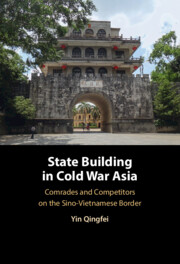Book contents
- Frontmatter
- Contents
- Figures
- Maps
- Acknowledgments
- Notes on Romanization, Names, and Pseudonymization
- Abbreviations
- Introduction
- 1 Asymmetric State Building (1949–1954)
- 2 Joint State Building (1954–1957)
- 3 Negotiated State Building (1958–1964)
- 4 Thwarted State Building on the Sea (1954–1964)
- 5 Reversed State Building (1965–1975)
- Conclusion
- Bibliography
- Index
1 - Asymmetric State Building (1949–1954)
Published online by Cambridge University Press: 18 December 2024
- Frontmatter
- Contents
- Figures
- Maps
- Acknowledgments
- Notes on Romanization, Names, and Pseudonymization
- Abbreviations
- Introduction
- 1 Asymmetric State Building (1949–1954)
- 2 Joint State Building (1954–1957)
- 3 Negotiated State Building (1958–1964)
- 4 Thwarted State Building on the Sea (1954–1964)
- 5 Reversed State Building (1965–1975)
- Conclusion
- Bibliography
- Index
Summary
This chapter examines how the Chinese and Vietnamese communists’ perceptions of the border, and their priorities and ability to project state power there, changed as they transformed from revolutionary insurrectionists to ruling elites during 1949–1954. As more areas under DRV’s control connected with Chinese territory, the Chinese and Vietnamese communists started to jointly enforce the international boundary, enhance the cohesion of state authorities over the margins of their power, and extract revenues by controlling cross-border flows of goods and people during the First Indochina War. State building by the Chinese and Vietnamese Communists at the border, however, remained asymmetric during this period. Due to the two parties’ different status in their respective countries, the contested social spaces of borderlands posed greater dangers to the Chinese revolutionary state during its political consolidation while offering greater opportunities to the wartime DRV state to obtain material for its struggle against the French colonial troops. During the First Indochina War, the Sino-Vietnamese border was a site of selective coercion. Both the PRC and the DRV steadily expanded their economic functions by extracting taxes and thrusting state-owned trade companies into the existing cross-border commercial networks.
Keywords
- Type
- Chapter
- Information
- State Building in Cold War AsiaComrades and Competitors on the Sino-Vietnamese Border, pp. 36 - 75Publisher: Cambridge University PressPrint publication year: 2024

